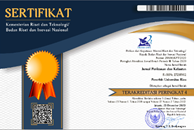Characteristics of Mangrove Forest in Anak Setatah Village Riau Province for Community-Based Tourism Village Development
(1) Jurusan Ilmu Kelautan Fakultas Perikanan dan Kelautan Universitas Riau
(2) Fakultas Perikanan dan Kelautan Universitas Riau
(3) Fakultas Perikanan dan Kelautan Universitas riau
(4) Universitas Riau
(*) Corresponding Author
Abstract
Keywords
Full Text:
PDFReferences
Arida, I. N. S dan P. Kerti. 2017. Kajian penyusunan kriteria-kriteria desa wisata sebagai instrumen dasar pengembangan desa wisata. Jurnal Analisis Pariwisata. Vol. 17(1): 1-9.
Dewi, M. H. U. 2013. Pengembangan desa wisata berbasis partisipasi masyarakat lokal di Desa Wisata Jatiluwih Tabanan, Bali. Kawistara. Vol. 3(2): 117-226.
Gautama, B. P, K. Y. Ayu, S. N. Netti, F. Endah dan I.P. Ilma. 2020. Pengembangan desa wisata melalui pendekatan pemberdayaan masyarakat. Jurnal Pengabdian Kepada Masyarakat. Vol. 1(4): 356-369.
Marhawati, A. Rahmadani, Astry, Gunawan, Minarni, Rosmaladewi dan U. Khatimah. 2021. Pemberdayaan masyarakat dalam upaya pelestarian ekosistem pesisir dan hutan mangrove di Pulo Kambing Kecamatan Pitumpanua Kabupaten Wajo. Jurnal Lepa-lepa. Vol. 1 (3): 386-392.
Paruntu, C. P; B. Agung; I. Windarto dan M. Mamesah. 2016. Mangrove dan pengembangan silvofishery di wilayah pesisir Desa Arakan Kecamatan Tatapaan Kabupaten Minahasa Selatan. Jurnal LPPM Bidang Sains dan Teknologi. Vol. 3 (2).
Pemkab Kepulauan Meranti. 2022. Kabupaten Kepulauan Meranti. http://p2kp.stiki.ac.id/id3/2-3060-2956/Kabupaten-Kepulauan-Meranti_28294_p2kp-stiki.html. Diunduh tanggal 4 Februari 2022.
Sumar. 2020. Penanaman mangrove sebagai upaya pencegahan abrasi di pesisir pantai Sabang Ruk Desa Pembaharuan. Jurnal Ikraith-Abdimas. Vol. 4 (1): 126-130.
Wahyuningsih, D. S, E. Maulana, T. R. Wulan, W. Ambarwulan, M. D. Putra, F. Ibrahim dan A. S. Putra. 2016. Efektivitas upaya mitigasi abrasi berbasis ekosistem di Kabupaten Kulonprogo, Daerah Istimewa Yogyakarta. Prosiding Seminar Nasional Kelautan. Universitas Trunojoyo Madura.
Wahyuni, D. 2018. Strategi pemberdayaan masyarakat dalam pengembangan desa wisata Nglanggeran, Kabupaten Gunung Kidul. Aspirasi: Jurnal Masalah-Masalah Sosial. Vol. 9(1): 83-100.
Yowaty, D, I. Effendi, Nursyirwsni, J. Samiadji dan M. Razali. 2020. Analisis potensi pengembangan ekowisata hutan mangrove di Kampung Sungai Kayu Ara Kabupaten Siak Provinsi Riau. Jurnal Berkala Terubuk. Vol. 48 (3): 775-787.
Yoswaty, D. 2021. Pembagunan pariwisata yang berkelanjutan di Kecamatan Sungai Apit Provinsi Riau: Faktor ekowisata mangrove. Jurnal Perikanan dan Kelautan Universitas Riau. Vol 26 (23): 205-2013.
Yulianda, F. 2019. Ekowisata perairan suatu konsep kesesuaian dan daya dukung wisata bahari dan wisata air tawar. Bogor: IPB Press.
Zakaria, F dan D. S. Rima. 2014. Konsep pengembangan kawasan desa wisata di Desa Bandungan Kecamatan Pakong Kabupaten Pamekasan. Jurnal Teknik POMITS. Vol. 3(2): 46-249.
Article Metrics
Abstract view : 215 timesPDF - 291 times
DOI: http://dx.doi.org/10.31258/jpk.27.1.114-123
Copyright (c) 2022 Jurnal Perikanan dan Kelautan

This work is licensed under a Creative Commons Attribution-NonCommercial-NoDerivatives 4.0 International License.
Gedung Marine Center Lt 2. Fakultas Perikanan dan Kelautan Universitas Riau



